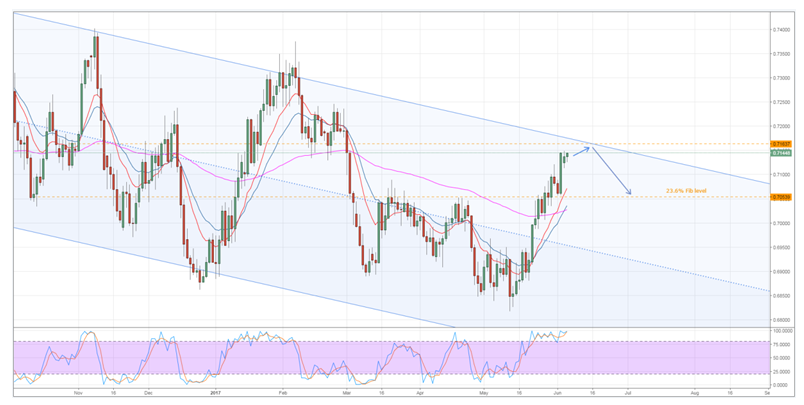Key Points:
- We could be approaching a near-term peak for the NZD.
- The technical bias is suggesting that a reversal is warranted.
- Losses likely to be capped at the 0.7053 handle.
The kiwi dollar may need to moderate slightly in the coming days as a number of technical signals are beginning to cast doubt on hopes of extending gains significantly in the near-term. Nevertheless, we may not have reached our reversal point just yet which could mean that we still have a small degree of ground left to be claimed – especially if the impending GDT Price Index comes in above targets.
Firstly, if we look at the daily chart, it is becoming apparent that the pair is beginning to encounter some rather stiff resistance which could, eventually, result in a reversal for the NZD. In particular, the presence of a historical point of inflection and the upside of the regression channel are working against the bulls – likely meaning gains will be capped by the 0.7163 handle. However, we obviously haven’t quite hit this price just yet which could mean we don’t see a correction begin for a couple of sessions.

Regardless, any further gains will bring the NZD into conflict with the 0.7163 handle which could spell the end of the recent uptrend. Subsequently, the pair should move into retreat, at least until the stochastics and RSI have moved out of overbought territory. However, this would almost definitely invert the Parabolic SAR reading to bullish which could see a sizable tranche of losses begin. Despite this, our current bias is that the kiwi dollar sinks to the 0.7053 handle and no further, largely due to the 100 day EMA providing dynamic support around this price.
As for the fundamental side of things, the release of the GDT Price Index this week should work in concert with the technical forecast. On the one hand, if we see a yet another increase in the figure, upsides will be present but not too aggressive as a positive outcome has largely been priced in. On the other hand, if a negative print is seen, it will simply kick start the downtrend that has been described above. This being said, don’t expect to see the pair go into free fall as the index is still at its highest point since mid-2014.
Ultimately, despite some residual buying pressure, the outlook for the NZD is rather bearish. As mentioned, the presence of that resistance level around the 0.7163 handle could prove to be a near-term high for the pair and a downtrend could begin once it has been tested properly. Nevertheless, not all is doom and gloom as there is a decent chance that losses are capped at 0.7053 which leaves the pair in possession of most of the gains made over the past month.
